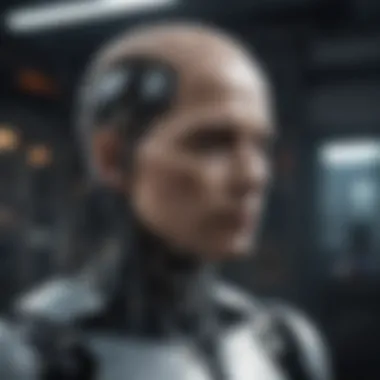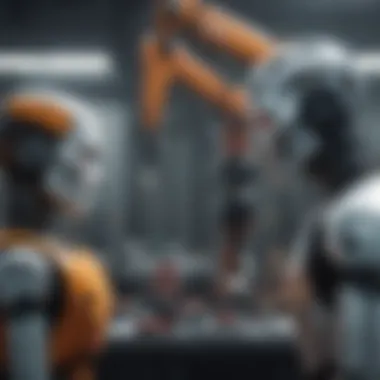AI-Enabled Robots: Redefining Automation's Future


Intro
The intersection of artificial intelligence and robotics has rapidly grown into a focal point of discussion among scholars, technologists, and industry leaders. As we envision the future, the integration of AI into robotics stands as a structural shift in automation. This transformation not only streamlines production and efficiency but also reshapes workforce dynamics.
In today's environment, AI-enabled robots are not merely mechanical solutions to manual tasks. They are sophisticated systems capable of learning, adapting, and making decisions. This evolution has sparked interest in various fields, making it essential to examine the underlying currents that are driving this remarkable progress.
Prologue to AI-Enabled Robots
The advent of AI-enabled robots has initiated a significant transformation in various industries. These robots, which integrate artificial intelligence with robotic systems, provide not only enhanced efficiency but also improve consistency in complex tasks. As sectors become increasingly reliant on automation to optimize productivity, it is essential to understand the role that AI-enabled robots play in shaping this future.
By intertwining AI technologies with robotics, these machines gain the capacity to learn from their environments, adapt their responses, and perform tasks autonomously. This capability shifts the paradigm from traditional robotics, which often involves pre-programmed actions, to systems that can evolve and improve over time. The implications of this shift are far-reaching, potentially redefining workflows and enhancing innovation across industries.
Benefits surrounding AI-enabled robots include:
- Increased Efficiency: Automation allows for round-the-clock productivity.
- Quality Consistency: Robots perform routine tasks with a level of precision that minimizes human error.
- Enhanced Safety: In hazardous environments, these robots can operate without risks to human health.
However, the integration of AI in robotics also presents considerations that require attention. Issues such as ethical practices and safety standards must be addressed, given that deploying autonomous machines raises questions about accountability. Furthermore, implications for employment and the workforce cannot be overlooked as automation expands.
Overall, the discussion surrounding AI-enabled robots serves to underscore their critical role in future automation strategies and the necessity for ongoing evaluation of their impact on society.
Definition and Key Concepts
AI-enabled robots blend the physical aspects of robotics with cognitive functionalities facilitated by AI. This definition encompasses various components such as machine learning, sensory processing, and real-time decision-making capabilities. The fusion of these elements enables robots to carry out operations traditionally reserved for human workers which can range from simple tasks to complex problem-solving.
Historical Perspective
To appreciate the current evolution of AI-enabled robots, it is essential to examine their historical context. The concept of robotics dates back to ancient civilizations, but significant milestones occurred in the twentieth century. Early advancements in electronics and computer science laid the groundwork for automation. The development of early robots during the mid-1900s marked the beginning of this technological revolution.
By the 1980s, robotic arms became a common sight in manufacturing, primarily for repetitive tasks. However, these early iterations lacked the intelligent processing needed for adaptability. With the emergence of machine learning and enhanced computational capabilities in the late twentieth century, robotics began to shift. Implementing AI algorithms created avenues for more sophisticated interactions and capabilities, ushering in the current era of AI-enabled robots that are knowledgeable and versatile.
As this section unfolds within the article, it provides crucial insights into the definition and historical trajectory of AI-enabled robots, establishing a foundation for exploring their technological underpinnings, applications, and future implications on society.
Technological Foundations of AI in Robotics
The intersection of artificial intelligence and robotics is fundamentally reshaping how industries operate. Understanding the technological foundations of AI in robotics helps in grasping the magnitude of this transformation. Various components come together to empower robots, enhancing their efficiency, adaptability, and decision-making abilities.
Machine Learning in Robotics
Machine learning is a critical element in the functionality of AI-enabled robots. This field uses algorithms to enable machines to learn from and make predictions based on data. The contributions of machine learning manifest in several ways, with supervised, unsupervised, and reinforcement learning being the main types used in robotics.
Supervised Learning
Supervised learning involves training a model on a labeled dataset, where the output is known. The primary characteristic of supervised learning is its ability to improve prediction accuracy through iterative training. This method is effective for tasks such as recognizing patterns and classifying data. Its popularity in robotics springs from its clarity and ease of integration into various applications. However, supervised learning requires substantial amounts of labeled data, which can be resource-intensive to curate.
Unsupervised Learning
Unsupervised learning differs by working with unlabelled data. It identifies patterns or clusters without predefined outcomes. A key feature of unsupervised learning is its ability to explore data autonomously. This method is beneficial for creating systems that can adapt to new, unseen scenarios. Despite its advantages, it can lead to challenges in understanding results, as the outputs may not always be interpretable or straightforward.


Reinforcement Learning
Reinforcement learning is defined by its focus on training models through a system of rewards and penalties. The unique aspect of this approach is its adaptability; it allows robots to learn from their own experiences in dynamic environments. Reinforcement learning is particularly suited for tasks where explicit instructions are impractical, such as robotic navigation. However, this method can require significant time and resources to reach optimum performance levels.
Computer Vision and Perception
Computer vision plays an essential role in how robots navigate and interact with their surroundings. This technology enables machines to interpret visual data, paving the way for more sophisticated interaction capabilities. Image recognition techniques and object detection algorithms are two crucial components in this realm.
Image Recognition Techniques
Image recognition involves identifying and classifying objects within images. The main characteristic of image recognition techniques is their ability to discern details in visual data. These techniques are beneficial particularly in contexts where robots need to identify items, such as in manufacturing and quality control environments. However, they may struggle with variability in lighting conditions or angles, impacting their reliability.
Object Detection Algorithms
Object detection algorithms go a step further, not only recognizing objects but also locating them within an image. The significance of these algorithms lies in their ability to provide spatial awareness, which is vital for robots operating in complex environments. While they enhance operational capabilities, issues such as speed and computational load can hinder performance, especially in real-time scenarios.
Natural Language Processing
The ability to understand and generate human language forms a critical pillar in making robots more interactive. Natural language processing (NLP) allows robots to communicate effectively, interpret commands, and manage tasks based on spoken or written language. This capability enhances user experience, making robots more accessible for a variety of applications from customer service to healthcare.
In summary, the technological foundations of AI in robotics encompass several vital components. By leveraging machine learning, computer vision, and natural language processing, robots become increasingly autonomous and capable. This integration not only boosts efficiency but also transforms the landscape of automation across industries.
Applications of AI-Enabled Robots
Artificial intelligence in robotics has sparked extensive transformations across numerous industries. Understanding the applications of AI-enabled robots adds depth to our insight about their role in shaping automation. Each subset of applications highlights unique benefits and challenges, enabling us to appreciate their complexity and relevance in today’s world.
Manufacturing and Industrial Automation
Robotic Assembly Lines
Robotic assembly lines significantly enhance production efficiency and precision. These systems integrate multiple robotic arms to perform tasks such as welding, painting, and assembling components. The key characteristic that makes robotic assembly lines popular is their ability to operate continuously, reducing downtime. This feature maximizes productivity but requires high initial investment and maintenance costs. Despite these concerns, the enhancement in output quality remains a noteworthy advantage.
Predictive Maintenance
Predictive maintenance is vital for reducing unplanned downtimes in manufacturing processes. AI algorithms analyze data from machinery to predict failures before they happen. This proactive approach minimizes costly interruptions in production. Its importance lies in optimizing asset longevity and productivity. Although predictive maintenance necessitates a comprehensive data collection system, its long-term savings and efficiency overshadow initial challenges.
Healthcare and Medical Robotics
Surgical Robotics
Surgical robotics is a groundbreaking application of AI that enhances the precision of surgical procedures. These systems empower surgeons with improved control and visualization, significantly reducing recovery times for patients. The adoption of robotic-assisted surgeries is growing due to their ability to minimize human error. However, high costs and the need for specialized training pose challenges for wider implementation.
Patient Care Assistants
In healthcare, patient care assistants leverage AI technologies to support elderly and disabled individuals. These robots can perform tasks like medication reminders and mobility assistance. The key characteristic of these machines is their capability for personalization, as they learn the preferences and behaviors of the individuals they assist. While they improve the quality of life, concerns regarding privacy and emotional connections with machines remain considerations for ongoing discussions.
Service Robots
Hospitality Industry


Service robots have entered the hospitality industry, transforming customer service experiences. From robotic concierges to automated room service delivery, these technologies offer efficiency and novelty. The primary advantage of service robots is their ability to operate without breaks, ensuring swift service. However, reliance on machines may lead to a reduction in jobs, causing ethical and practical dilemmas within the industry.
Logistics and Delivery Services
In logistics, AI-enabled robots streamline processes like sorting and delivering goods. Automated guided vehicles can navigate warehouses and transport items quickly. Their essential role is enhancing the speed and accuracy of services. Nonetheless, the initial setup costs and ongoing maintenance can be significant, which some smaller businesses may find challenging.
Military and Defense Applications
Autonomous Drones
Autonomous drones have redefined surveillance and intelligence-gathering operations in military contexts. Equipped with advanced AI, these drones can make decisions during missions, adapting to changes in their environment. Their primary advantage lies in reducing human risk in dangerous situations. Yet, ethical questions regarding their use in warfare necessitate careful examination.
Explosive Ordnance Disposal Robots
Explosive ordnance disposal robots offer crucial support in hazardous environments. These robots safely neutralize bombs and other explosive threats, protecting soldiers and civilians alike. Their ability to navigate complicated terrains without human intervention demonstrates their effectiveness. However, the reliance on technology in life-or-death scenarios raises questions about reliability and decision-making in crisis situations.
Overall, the applications of AI-enabled robots demonstrate their significant contributions to various fields while revealing challenges and considerations unique to each sector. As technology continues to evolve, these robots will likely become increasingly integral in daily operations and complex tasks alike.
Challenges in Developing AI-Enabled Robots
The development of AI-enabled robots presents a series of significant challenges that must be thoroughly addressed to ensure their successful integration into various sectors. This section highlights crucial elements such as technical limitations and ethical concerns. Understanding these challenges is essential for advancing the technology while being aware of its implications on society. The balance between technological capabilities and ethical considerations will play a key role in shaping the future of automation.
Technical Limitations
Real-Time Decision Making
Real-time decision making is a critical aspect of AI-enabled robots. It involves processing data and making immediate decisions based on that data during operation. This capability is vital for robots deployed in dynamic environments, where conditions can change rapidly. The key characteristic of real-time decision making is its necessity for quick, accurate responses. For instance, in manufacturing, a robot must adjust its actions instantaneously to avoid collisions or errors in assembly.
One unique feature of real-time decision making is the reliance on advanced algorithms. These algorithms process enormous amounts of input data to execute actions effectively. The advantages include enhanced safety and efficiency in operations. However, there are disadvantages as well. High computational demands can lead to delays or failures in decision making, which can be detrimental, especially in time-sensitive applications.
Energy Efficiency
Energy efficiency is another core technical aspect of AI-enabled robots. It refers to the ability of robotic systems to perform tasks while consuming minimal energy. This characteristic is crucial for prolonging operation time, especially in mobile robots, where battery life is a significant concern. The focus on energy efficiency aligns with global objectives to reduce carbon footprints and promote sustainability.
A unique feature of energy efficiency is the integration of advanced power management systems. These systems can optimize energy use based on the robot's activity levels, leading to significant operational savings. While the advantages of improving energy efficiency are clear, challenges remain. Designing robots that are both powerful and energy-efficient can lead to increased production costs and complexity in development.
Ethical and Societal Issues
Job Displacement Concerns
Job displacement concerns emerge when discussing AI-enabled robots, focusing on the potential replacement of human workers. This challenge arises from the efficiency and effectiveness of robots in performing repetitive or hazardous tasks. The key characteristic of this issue lies in its societal implications. As robots become increasingly capable, the fear of job loss grows, leading to significant social friction.
One unique feature of job displacement concerns is the need for workforce reskilling. As certain jobs diminish, there is a corresponding demand for new skills and roles, which may lead to economic shifts. The advantages of this change can be a more skilled workforce that can engage in more complex, non-automatable tasks. Conversely, the disadvantages include short-term unemployment and the societal pressure to adapt rapidly to new job markets.
Accountability in Robotics
Accountability in robotics addresses the question of responsibility when AI-enabled robots make errors. This topic is crucial for understanding the legal and ethical ramifications of robot actions. The key characteristic here involves determining who is liable for the decisions made by autonomous systems. This aspect is a major consideration in regulatory frameworks concerning AI technology.


A unique feature of accountability in robotics is the challenge of defining legal responsibility. As robots operate increasingly independently, determining whether the manufacturer, programmer, or user is at fault becomes complex. Advantages include the potential for clear guidelines that can enhance public trust in robotic technology. However, disadvantages may involve legal ambiguity and difficulties in enforcement, which could hinder the adoption of these systems.
"As we navigate the landscape of AI-enabled robotics, we must confront both the technical and ethical challenges, ensuring that progress does not come at the expense of societal wellbeing."
"As we navigate the landscape of AI-enabled robotics, we must confront both the technical and ethical challenges, ensuring that progress does not come at the expense of societal wellbeing."
The Future of AI and Robotics
The advancement of artificial intelligence is reshaping various fields, with robotics being on the forefront of this transformation. Understanding the future of AI and robotics is crucial for recognizing potential growth in this sector. AI-enabled robots offer superior efficiency and task adaptability. They can learn from their environments, thereby improving their processes over time. As technology progresses, the integration of AI in autonomous systems will enhance productivity and redefine human roles within workplaces.
Emerging Trends
Collaborative Robots (Cobots)
Collaborative Robots, or Cobots, are designed to work alongside humans. This specific aspect highlights their inherent capability to enhance human productivity. Cobots possess advanced sensors and AI technologies, allowing them to learn and adapt in real-time. This characteristic makes them not only helpful but also a safer alternative in environments where human and robot interactions are necessary. A key advantage of Cobots is their ease of use. They can be programmed without extensive technical knowledge, appealing to a wide range of industries, from manufacturing to healthcare.
However, the reliance on Cobots may raise concerns about job displacement. Organizations must consider how to implement these robots without undermining the workforce's value.
Swarm Robotics
Swarm Robotics mimics natural behaviors seen in social animal species, such as ants or bees. The key characteristic of this trend is its decentralized approach to problem-solving. Swarm robots can cooperate and communicate to perform complex tasks efficiently. This approach is particularly beneficial for applications like environmental monitoring and disaster response, where scalable and flexible solutions are necessary.
One unique feature of Swarm Robotics is their ability to adapt to dynamic environments. While their cooperative nature is a distinct advantage, challenges remain in terms of synchronization and data management among robots, which could complicate the development process.
Long-term Implications
The Role of AI in Human-Robot Interactions
The relationship between humans and robots will be crucial in unfolding the future of work and automation. This aspect emphasizes the growing need for emotional intelligence in robots. AI technologies integrated into robots are evolving to understand and respond to emotional cues from humans. This characteristic makes interactions smoother and more intuitive, which is essential in service-oriented roles.
Moreover, the effective integration of AI in these interactions will enhance user trust and acceptance. However, reliance on AI for support in human interactions may create ethical dilemmas regarding privacy and emotional manipulation. These issues warrant thorough examination as technology becomes more widespread.
Potential for Autonomous Systems
The potential for autonomous systems is vast and multifaceted. This aspect illustrates the capabilities of AI-powered robots to operate without human intervention in various environments. The key benefit lies in increased operational efficiency and the ability to undertake tasks in hazardous conditions, such as disaster recovery or military applications.
Unique features of these systems include their ability to analyze vast amounts of data quickly for better decision-making. Nevertheless, autonomy raises questions about safety, accountability, and ethical usage. These challenges necessitate robust frameworks to ensure responsible implementation.
"The rise of AI-enabled robots brings promising advancements, yet challenges regarding ethics and workforce dynamics must be addressed."
"The rise of AI-enabled robots brings promising advancements, yet challenges regarding ethics and workforce dynamics must be addressed."
Ultimately, the future of AI and robotics involves a balance between leveraging technological advancements and addressing the societal implications that come with them. Ensuring that advancements benefit society as a whole will be key in redefining roles and responsibilities.
Culmination
The dialogue surrounding AI-enabled robots has gained significant momentum, not just as a technological phenomenon but also as a harbinger of change across various sectors. The importance of this topic lies in understanding how integration of artificial intelligence into robotics is reshaping the very essence of automation.
AI-enabled robots bring forth multiple benefits. They enhance efficiency, reduce human error, and allow for sophisticated data processing capabilities. In manufacturing, for example, robots equipped with machine learning can optimize production workflows, leading to cost savings and increased output. Similarly, in healthcare, surgical robots can perform intricate procedures with exactitude that surpasses traditional methods.
However, there are critical considerations to address. The deployment of AI in robotics brings forth ethical dilemmas. Questions regarding job displacement and accountability loom large. As machines assume roles previously held by humans, one must ponder the broader societal implications. It is crucial for policymakers and stakeholders to engage in dialogue regarding the socio-economic consequences of this shift.
Key Elements to Consider
- Technological Advancement: The rate at which AI is evolving means that robots will continue to become more capable. Understanding this trajectory is crucial for industries looking to adapt.
- Ethical Frameworks: Developing guidelines and frameworks is essential to mitigate potential pitfalls related to the integration of AI into robotics.
- Collaboration and Training: As robots become integral in various fields, the need for human-robot collaboration will necessitate new training programs to equip individuals with the skills to work alongside these technologies.



